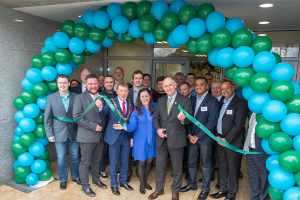Disaggregation + hardware virtualization : Pooled resrouces are key | #OCPSummit
![]() LSI is moving into contributing to Open Compute, said Robert Ober, the company’s System & Processor Architect, in a live interview with theCUBE co-hosts Dave Vellante and John Furrier from the Open Compute Project Summit in California. “We’ve been engaged and involved in Open Compute from the first time, but now we’re going to contribute.”
LSI is moving into contributing to Open Compute, said Robert Ober, the company’s System & Processor Architect, in a live interview with theCUBE co-hosts Dave Vellante and John Furrier from the Open Compute Project Summit in California. “We’ve been engaged and involved in Open Compute from the first time, but now we’re going to contribute.”
Explaining what they were going to contribute, Ober mentioned a design of the Nitro PCI flash cards, “the very first product that has been designed specifically for the Open Compute servers.” He explained it was “a product that you can plug directly into an open compute server and will work very, very well.”
The second contribution is Open Vault, the enclosure for the cold storage. “It uses some of our chips, some of our design. We realized it could be a lot better, improve the performance. We’re contributing the upgrades to the design,” Ober said.
Compromises in converged infrastructure
.
Discussing about the Nitro card and addressing the heat density issue, Ober said that where thermals are concerned, “if I think about the individual components, processors tend to run very hot. DRAM, it’s gonna need more frequent refreshes the hotter it is. Flash loves to run reasonably hot, but if you go over the edge, it falls apart. Disk drives as well have limits on thermals. Today, when you try to put everything in one box, and manage together, there is a lot of compromise. So you need to pull them apart.”
For LIS, it’s all about disaggregation, pulling the pieces apart and optimizing for each, having disparaging converged infrastructure.
Ober said he viewed disaggregation as “trying to resource pool.” With converged infrastructure, bladed systems, “the problem is, they tend to be architected as much to solve problems, as they are to lock in customers,” he stated.
Asked if the virtualization layer was coming down into individual components, Ober said “hardware virtualization is the direction we’re going. Hardware is deconstituted and pooled, storage is pooled and accessible from multiple servers.”
Economic perks to Open Compute
.
Commenting on what Open Compute targets and what the economic benefits were, Ober said “as soon as you start talking about a rack or more, you are going to naturally push into that hyperscale architecture that we’re seeing with Open Compute.” As for savings, at the extreme end, one of the company’s large enterprise customers mentioned 70 percent of their IT save. A safe range would be 30 to 50 percent.
Asked what was next in the industry, Ober mentioned “harmonizing the architecture between flash and disk and boot. There are new storage types coming, moving on to key value.” Photonics and optics, new memory types will also be extremely important.
See Ober’s entire segment below.
A message from John Furrier, co-founder of SiliconANGLE:
Your vote of support is important to us and it helps us keep the content FREE.
One click below supports our mission to provide free, deep, and relevant content.
Join our community on YouTube
Join the community that includes more than 15,000 #CubeAlumni experts, including Amazon.com CEO Andy Jassy, Dell Technologies founder and CEO Michael Dell, Intel CEO Pat Gelsinger, and many more luminaries and experts.
THANK YOU











